Variable-sweep wing
A variable-sweep wing, colloquially known as a "swing wing", is an airplane wing, or set of wings, that may be swept back and then returned to its original straight position during flight. It allows the aircraft's shape to be modified in flight, and is therefore an example of a variable-geometry aircraft.
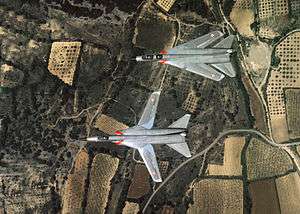
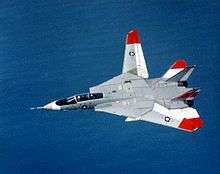
A straight wing is most efficient for low-speed flight, but for an aircraft designed for transonic or supersonic flight it is essential that the wing is swept. Most such fast aircraft usually have wings (either swept wing or delta wing) with a fixed sweep angle. These are simple and efficient wing designs for high speed flight, but there are performance tradeoffs. One is that the stalling speed becomes rather high, necessitating long runways (unless complex high-lift wing devices are built in). Another is that the aircraft's fuel consumption during subsonic cruise is higher than that of an unswept wing. These tradeoffs are particularly acute for naval carrier-based aircraft. A variable-sweep wing allows the pilot to use the optimum sweep angle for the aircraft's current speed, slow or fast. The more efficient sweep angles available offset the weight and volume penalties imposed by the wing's mechanical sweep mechanisms. Its greater complexity and cost make it practical mostly for military aircraft.
A number of successful and experimental designs were introduced from the 1940s into the 1970s; however, the recent advances in flight control technology and structural materials have allowed designers to closely tailor the aerodynamics and structure of aircraft, removing the need for variable sweep angle to achieve the required performance; instead, wings are given computer-controlled flaps on both leading and trailing edges that increase or decrease the camber or chord of the wing automatically to adjust to the flight regime. This is another form of variable geometry.
Characteristics
Variable sweep
A straight, unswept wing experiences high drag as it approaches the speed of sound, due to the progressive buildup of sonic shockwaves. Sweeping the wing at an angle, whether backwards or forwards, delays their onset and reduces their overall drag. However it also reduces the overall span of a given wing, leading to poor cruise efficiency and high takeoff and landing speeds.
A fixed wing must be a compromise between these two requirements. Varying the sweep in flight allows it to be optimised for each phase of flight, offering a smaller aircraft with higher performance. However it has disadvantages which must be allowed for. As the wing sweeps its centre of lift moves with it. Some mechanism, such as a sliding wing root or larger tail stabiliser, must be incorporated to trim out the changes and maintain level flight. The added weight of the sweep and trim mechanisms eat into the performance gains, while their complexity adds to cost and maintenance.
By moving the wing pivots outboard and only sweeping part of the wing, the trim changes are reduced, but so too is the variation in span and accompanying operational flexibility.
Wing controlled aerodyne
British engineer Barnes Wallis developed a radical aircraft configuration for high-speed flight, which he regarded as distinct from the conventional fixed-wing aeroplane and called it the wing controlled aerodyne. His previous work on the stability of airships had impressed on him the high control forces that could be exerted on the body of an aircraft, through very small deflections. He conceived of a simple ichthyoid (fish-like) fuselage with a variable wing. No other control surfaces were needed. Subtle movements of the wings were able to induce the small deflections which controlled the direction of flight, while trim was maintained by adjusting the angle of sweep to compensate for the varying position of the centre of lift at different speeds.[1][2]
For supersonic flight a delta-planform lifting body is more suitable than a simple ichthyoid. A conflict also arises between the wing sweep angle necessary for trim and the optimal angle for supersonic cruise. Wallis resolved this by moving mass, typically the engines, out to the wing tips and swivelling them as the wing swept in order to maintain the thrust line. In the asymmetric engine-out condition, the remaining engines could be swivelled to divert the thrust line closer to the centre of pressure and reduce the asymmetry to manageable levels.[1]
Asymmetric sweep
It is not necessary to sweep the port and starboard wings in the same sense - one can be swept back and the other forward, as in the oblique wing.
Varying the sweep asymmetrically by small amounts was also fundamental to the principle of the wing controlled aerodyne.
History
Origins
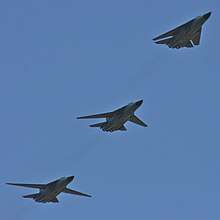
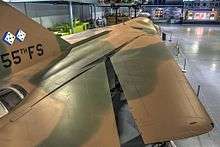
The earliest use of variable sweep was to trim the aeroplane for level flight. The Westland-Hill Pterodactyl IV of 1931 was a tailless design whose lightly swept wings could vary their sweep through a small angle during flight. This allowed longitudinal trim in the absence of a separate horizontal stabiliser.[3] The idea would later be incorporated in Barnes Wallis's wing controlled aerodyne.
In World War II German researchers discovered the advantages of the swept wing for transonic flight, and also its disadvantages at lower speeds. The Messerschmitt Me P.1101 was a research prototype developed to investigate the benefits of varying wing sweep. Its sweep angle could only be changed on the ground. However it was not yet completed when the war ended.[4]
Development
After the war the part-built P.1101 was taken to the United States for study at Bell Aircraft, but because of missing documentation and structural damage, Bell decided against completing it. A close copy, the Bell X-5, was constructed which featured wings that could adjust sweep angle in flight. As the wing swept back, the root also slid forwards, maintaining the centre of lift in a constant position.[5] A variable-sweep wing of this sliding type was flown on the prototype Grumman XF10F Jaguar in 1952, however the F10F proved unacceptable for other reasons and never entered service.
From the late 1940s, British engineer L. E. Baynes studied variable sweep, developing a method of varying the tail geometry as well in order to stabilise the centre of lift. No sliding mechanism was necessary, instead the wing wake interacted with the variable tail to effect the necessary trim changes. He lodged patent applications in 1949 and 1951.[6][7] The design was built and wind tunnel tests were completed, but due to budget constraints at the time, the government did not provide financial backing.
Independently from Baynes, British engineer Barnes Wallis was also developing a more radical variable-geometry concept, which he called the wing controlled aerodyne, to maximise the economy of high-speed flight. His first study was the Wild Goose project.[8] He then studied the Swallow,[8] intended to achieve a return flight from Europe to Australia in 10 hours. It had a blended wing tailless design and he successfully tested several models, including a six-foot scale model at speeds of up to Mach 2, in the 1950s, but in 1957, government backing was withdrawn for many aeronautical research and development programs, including Wallis' work.[9]
One outcome of Wallis's work was a visit to the US during which he collaborated with the NASA Langley Laboratory team of Alford, Polhamus on a design study for a variable-sweep fighter. Although it used the pivot mechanism he had developed, NASA also insisted on giving it a conventional horizontal stabiliser to ease the issues of trim and manoeuvrability. Although it was no longer the wing-controlled aerodyne that Wallis envisaged, it would prove a more practical solution than either his or Bell's for subsequent swing-wing designs. His work at Vickers also led to further studies, including a wing controlled aerodyne in response to OR.346 for a supersonic STOL fighter-bomber, then as BAC two further submissions: the Type 583 to meet Naval ER.206 and Type 584 to meet NATO NBMR.3, both also V/STOL requirements. One of their designers moved to Folland Aircraft where he proposed a variable-geometry supersonic development of the Gnat trainer and light fighter.[1]
Production
The idea emerged in the early 1960s when the United States adopted this configuration for the TFX (Tactical Fighter Experimental) program, which evolved into the General Dynamics F-111, the first production variable-sweep wing aircraft. The F-111 featured pivoting wing pylons (two under each wing) which automatically adjusted to the sweep angle. The Panavia Tornado and Sukhoi Su-24 would be similarly equipped.
Similar requirements in the Soviet Union also led TsAGI, the Soviet aerodynamics bureau, to study variable geometry. TsAGI evolved two distinct designs, differing mainly in the distance (expressed as a percentage of total wingspan) between the wing pivots. A wider spacing not only reduced the negative aerodynamic effects of changing wing sweep, but also provided a larger fixed wing section which could be used for landing gear or stores pylons. This could, in fact, be adapted to more-or-less existing airframes, which the Soviets soon did, with the Sukhoi Su-17 (based on the earlier swept wing Sukhoi Su-7). The limitation of the wide spacing, however, was that it reduced the benefits of variable geometry as much as it reduced their technical difficulties. For the new, "clean-sheet" Soviet designs, TsAGI devised a more narrowly spaced arrangement similar to that of the F-111. This design was used (albeit at different scales) for the MiG-23 fighter and the Sukhoi Su-24 interceptor, which flew in prototype forms at the end of the 1960s, entering service in the early 1970s. As of 2014 more than 100 Tupolev Tu-22M strategic bombers are in use.[10]
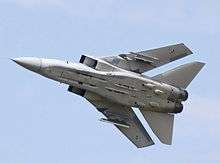
In the aftermath of the cancellation of TSR-2, BAC moved their variable-geometry work to Warton, there submitting the P.45 light attack/trainer to AST 362. This work fed into to the Anglo-French Variable Geometry aircraft (AFVG). When French commitment was curtailed, the British sought a second partner in the F-104 Consortium of European nations. This in turn led to the European consortium that adopted variable geometry for the Multi-Role Combat Aircraft (MRCA) project that emerged as the Panavia Tornado.[11] This was an interdictor and stand-off interceptor similar in function to the F-111, albeit on a smaller scale. After AFVG, Dassault Aviation built a prototype fighter in 1968, Dassault Mirage G, two variants Mirage G4 and G8,[12] and in cooperation with Ling-Temco-Vought, the LTV V-507 for VFX project.[13]
The U.S. Navy introduced the Grumman F-14 Tomcat in the 1970s to replace the canceled F-111B fleet interceptor with a fighter more nimble than the F-4 Phantom. Unlike the F-111, its variable-sweep wings were programmed automatically by speed and could be moved even during turns. In air combat, the wings could be swept forward for tight "bat" turns and back for dash speeds.[14][15]
Rockwell adopted variable geometry for the much larger Advanced Manned Strategic Bomber (AMSA) program that produced the B-1 Lancer bomber, intended to provide an optimum combination of high-speed cruising efficiency and fast, supersonic penetration speeds at extremely low level. In response the Soviet Tupolev Tu-160 "Blackjack" strategic bomber, which first flew in 1980.
Obsolescence
A variable-sweep wing was selected as the winning design used by Boeing's entry in the FAA's study for a supersonic transport, the 2707. However it evolved through several configurations during the design stage, finally adding a canard, and it eventually became clear that the design would be so heavy that it would be lacking sufficient payload for the fuel needed. The design was later abandoned in favor of a more conventional tailed delta wing.
The advent of relaxed stability flight control systems in the 1970s negated many of the disadvantages of a fixed platform. No new variable-sweep wing aircraft have been built since the Tu-160 (produced until 1992), though it has been noted that the F-14's replacement – the F/A-18E – has a reduced payload/range capability largely because of its small fixed wings.[14]
In 2015, the Russian Ministry of Defence announced plans to restart Tu-160 production, citing the aging of the current aircraft and likely protracted development of its eventual replacement, the PAK DA project.[16][17] Production is planned to restart in 2020, marking the first new variable sweep airframes to be produced in 28 years.[18][19]
List of variable-sweep aircraft
| Type | Country | Class | Role | Date | Status | No. | Notes |
|---|---|---|---|---|---|---|---|
| Bell X-5 | USA | Jet | Research | 1951 | Prototype | 2 | Development of the Messerschmitt P.1101 (qv) allowing sweep variation in-flight. |
| Dassault Mirage G | France | Jet | Fighter | 1967 | Prototype | 3 | |
| General Dynamics F-111 | USA | Jet | Fighter-bomber | 1964 | Production | 563 | |
| Grumman XF10F Jaguar | USA | Jet | Fighter | 1952 | Prototype | 1 | 2nd example not flown. |
| Grumman F-14 Tomcat | USA | Jet | Fighter | 1970 | Production | 712 | |
| Messerschmitt P.1101 | Germany | Jet | Research | 1945 | Project | 0 | 1 unfinished airframe. Wings variable to 3 pre-set positions only while on the ground. |
| Mikoyan-Gurevich MiG-23 | USSR | Jet | Fighter | 1967 | Production | 5,047 | |
| Mikoyan-Gurevich MiG-27 | USSR | Jet | Attack | 1970 | Production | 1,075 | Development of the MiG-23. |
| Panavia Tornado (MRCA) | International | Jet | Multirole | 1974 | Production | 992 | |
| Rockwell B-1 Lancer | USA | Jet | Bomber | 1974 | Production | 104 | |
| Sukhoi Su-17, 20 & 22 | USSR | Jet | Fighter-Bomber | 1966 | Production | 2,867 | |
| Sukhoi Su-24 | USSR | Jet | Attack | 1970 | Production | 1,400 (approx) | |
| Tupolev Tu-22M | USSR | Jet | Bomber | 1969 | Production | 497 | |
| Tupolev Tu-160 | USSR | Jet | Bomber | 1981 | Production | 36 | |
| Vickers Wild Goose | UK | UAV | Research | 1950 | Prototype | 1 | Designed by Barnes Wallis.[20] |
| Vickers Swallow | UK | Jet | Airliner | 1957 | Project | 0 | Designed by Barnes Wallis. Small-scale test UAV flown. |
| Westland-Hill Pterodactyl IV | UK | Propeller | Private | 1931 | Prototype | 1 | Variable 4.75° for trim.[21] |
See also
| Wikimedia Commons has media related to Variable-sweep wings. |
- Adaptive compliant wing
- Variable-incidence wing
- Variable camber wing
References
Citations
- Wood, 1975.
- Morpurgo, 1981.
- Lukins A H, The book of Westland aircraft, Aircraft (Technical) Publications Ltd.
- Aeronautical Research in Germany-from Lilienthal until Today, Hirschel Prem and Madelung, ISBN 978-3-642-62129-1, p. 336
- Airplane Stability and Control, Second Edition, Abzug and Larrabee, ISBN 978-0-521-02128-9, p. 244
- UK Patent GB664058A, Espacenet
- UK Patent GB713525A, Espacenet
- "Barnes Wallis Supersonics, Wild Goose (accessed 23 September 2018)". Archived from the original on 10 October 2018. Retrieved 23 September 2018.
- "Swing Wing." Archived 2007-04-06 at the Wayback Machine The Barnes Wallis Memorial Trust. Retrieved: 14 May 2013.
- Hoyle, Craig (26 September 2014), "Kings of the swingers: Top 13 swing-wing aircraft", Flightglobal, Reed Business Information, archived from the original on 27 September 2014, retrieved 27 September 2014
- Buttler, Tony. British Secret Projects: Jet Bombers Since 1949.
- Green, William. The Observer's Book of Aircraft. London. Frederick Warne & Co. Ltd., 1972. ISBN 0-7232-1507-3, p. 84.
- Claude Carlier, Une formule aérodynamique gagnante. La grande aventure des «Mirage» à géométrie variable, 2, Le Fana de l’aviation, 537, août 2014
- Kress, Bob and RADM Gilchrist USNRet. "F-14D Tomcat vs. F/18 E/F Super Hornet." Archived 2009-04-04 at the Wayback Machine Flight Journal Magazine, February 2002 Issue. Quote: "dedicated air combat occurs at below about 0.8 because of high turning drag – an arena in which the F-14's 20-degree sweep is optimal ... it has only 36 percent of the F-14's payload/range capability.
- "Fact file: F-14 Tomcat". 11 December 2002. Archived from the original on 2009-03-30. Retrieved 2009-01-22.
- "'Blackjack' comeback: Russia to renew production of its most powerful strategic bomber". RT. 29 April 2015. Archived from the original on 1 May 2015. Retrieved 20 November 2015.
- Stevenson, Beth (30 April 2015). "Russia to reestablish Tu-160 supersonic bomber production line". Flightglobal. Archived from the original on 17 December 2015. Retrieved 20 November 2015.
- "Putin made decision to revive production of Tu-160M strategic bomber — Air Force commander". TASS. 28 May 2015. Archived from the original on 23 June 2015. Retrieved 20 November 2015.
- "Tu-160M2 Supersonic Strategic Bomber: 'Practically a New Plane Under the Hood'". Archived from the original on 2016-08-20. Retrieved 2016-11-12.
- Morpurgo, 1981. Date of first flight, p. 321.
- Lukins, A.H.; The Book of Westland Aircraft, Aircraft (Technical) Publications Ltd, 1943 or 1944. pp.68-9.
Bibliography
- J.E. Morpurgo; Barnes Wallis: A Biography, 2nd Edn, 1981. (1st Edn, Longmans, 1972).
- Derek Wood; Project Cancelled, Macdonald and Jane's, 1975. Chapter 11, Swing Wings: Variable Geometry.
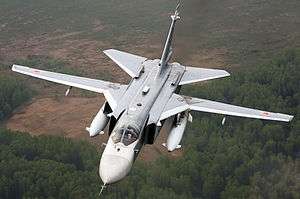
.jpg)